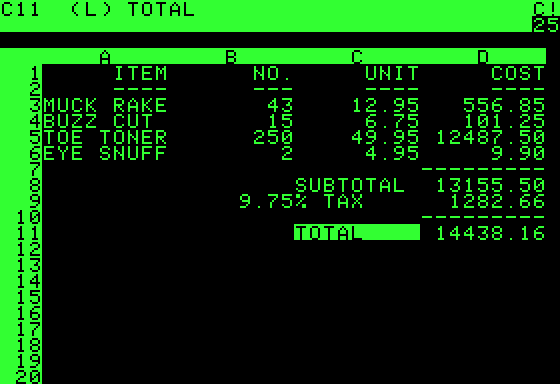Killer apps: Spreadsheets
VisiCalc

VisiCalc, initially called "Calcu-ledger", was invented by Dan Bricklin in 1978. It was in those year, when he was still a student at the Harvard Business School, that he thought about creating a new way to do calculations: he wanted to build something like a calculator which could be controlled using a mouse and a keyboard. He wrote a first working prototype on an Apple II, using Apple Basic. It was simple and it couldn't do much, but it worked. He kept on working on VisiCalc with the help of his friend Bob Frankston, and not much time later they founded together Software Arts.
The first version of the program was released in 1979. At the time there were other similar programs, but their product offered a completely new kind of interaction, and it also run on personal computers. After some problems with memory size, solved when the more powerful Apple II 48k came out, the distribution of the program started thanks to Personal Software, which at the time was one of the biggest software publisher for personal computers. The software was a huge success, thanks to its simple interface and its revolutionary concept. Since at first it was only available for the Apple II, a lot of people ended up buying the machine only to be able to use VisiCalc, which became one of the first killer applications ever.
In the following years the program was ported to many different machines, like the Commodore PET and the IBM PC. Although not all the ports were as good as the original version, they were good enough to boost the sales of those machines. In those years some competitors appeared: while those programs were actually better than VisiCalc, Software Arts' product was still preferred, thanks to the fame it gained in those years. The problems came when Lotus 1-2-3 was released. Written by Jonathan Sachs, this software offered better performance and was generally better than VisiCalc. Also, Lotus 1-2-3 tried to remain as similar to VisiCalc as possible, imitating its structure and appearance, so that the users could easily go from VisiCalc to Lotus 1-2-3 without really having to learn the new software. Lotus 1-2-3 gained the control of the whole market, and in 1985 Personal Software, now VisiCorp, sold Software Arts to Lotus Development.
Lotus 1-2-3

Lotus 1-2-3 was written by Jonathan Sachs in 1982, when he joined Mitch Kapor, an ex employee of VisiCalc, to found Lotus Development Corporation. The name 1-2-3 indicated that it wasn't just a spreadsheet: it also permitted to create charts and it offered simple database operations.
In 1983 their product, Lotus 1-2-3, started to take control of the market which used to be dominated by VisiCalc. This software was first created in C for the Apple II: only later it was then rewritten in assembly language for the IBM PC. The change of language permitted the software to become much faster and more efficient than its competitors. The fact that it was only available for the PC permitted the software to be more well-finished. Thanks to its widespread success, Lotus 1-2-3 became the first killer application for the personal computer.
The slow decline of Lotus 1-2-3 started with the arrival of Microsoft Excel, successor of Multiplan. In 1987 Excel was ported to the personal computer: even though it didn't look like a serious competitor, in that period Lotus 1-2-3 was having technical issues, with the delay of their third version by more than a year. This permitted Excel to start gaining ground, becoming more and more popular in the personal computer market.
External Links
- [Visited on 06/11/2014] Image taken from Wikipedia
- [Visited on 06/11/2014] Image taken from Wikipedia, fair use intended
- [Visited on 06/11/2014] Dan Bricklin's page on the Idea of VisiCalc
- [Visited on 06/11/2014] A Brief History of Spreadsheets
- [Visited on 06/11/2014] Wikipedia page on VisiCalc
- [Visited on 06/11/2014] Lotus 1-2-3 turns 30 – interview with the developer Jonathan Sachs
- [Visited on 06/11/2014] Historical Background of Spreadsheets
- [Visited on 06/11/2014] Wikipedia page on Lotus 1-2-3